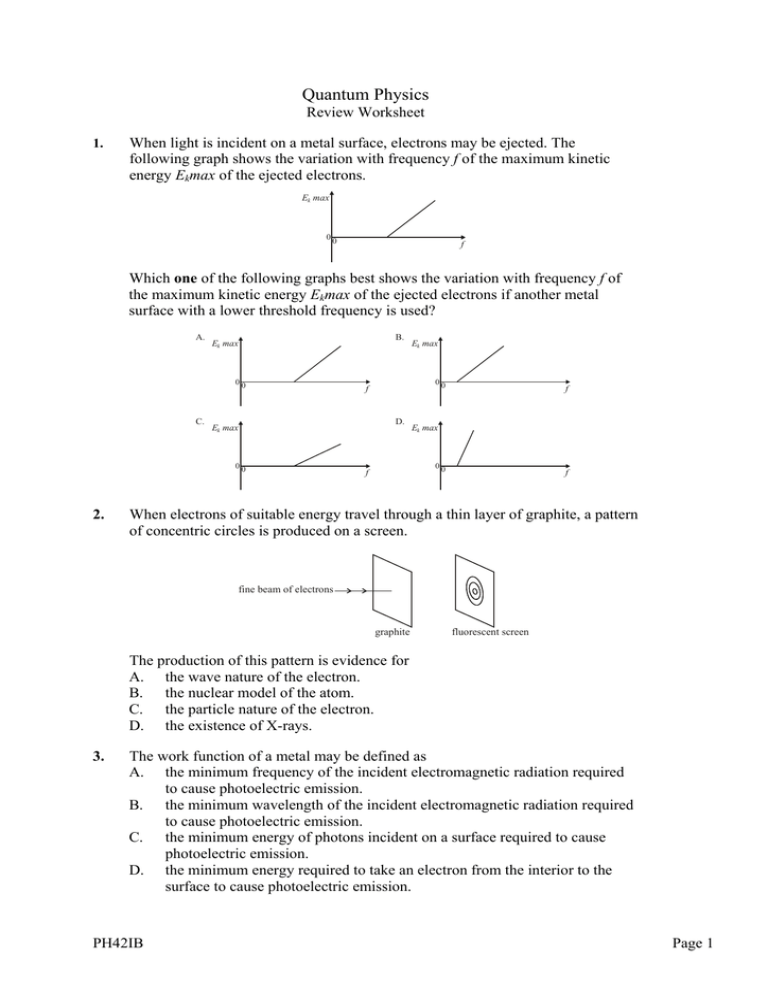Quantum Physics
advertisement

Quantum Physics Review Worksheet 1. When light is incident on a metal surface, electrons may be ejected. The following graph shows the variation with frequency f of the maximum kinetic energy Ekmax of the ejected electrons. Ek max 00 f Which one of the following graphs best shows the variation with frequency f of the maximum kinetic energy Ekmax of the ejected electrons if another metal surface with a lower threshold frequency is used? A. B. Ek max 00 C. D. 00 2. 00 f Ek max Ek max f Ek max 00 f f When electrons of suitable energy travel through a thin layer of graphite, a pattern of concentric circles is produced on a screen. fine beam of electrons graphite fluorescent screen The production of this pattern is evidence for A. the wave nature of the electron. B. the nuclear model of the atom. C. the particle nature of the electron. D. the existence of X-rays. 3. The work function of a metal may be defined as A. the minimum frequency of the incident electromagnetic radiation required to cause photoelectric emission. B. the minimum wavelength of the incident electromagnetic radiation required to cause photoelectric emission. C. the minimum energy of photons incident on a surface required to cause photoelectric emission. D. the minimum energy required to take an electron from the interior to the surface to cause photoelectric emission. PH42IB Page 1 4. An electron of mass me and a proton of mass mp are moving with the same speed. The de Broglie wavelengths associated with the electron and with the proton are λe and λp respectively. λp The ratio mp A. me is equal to B. . mp C. 5. λe me D. . me . mp me . mp In an experiment to demonstrate the photoelectric effect, light of intensity L and frequency f is incident on a metal surface. The maximum photoelectric current is I and the stopping potential is VS What change if any occurs in the maximum photoelectric current and in the stopping potential when light of the same intensity L but of frequency 2f is incident on the surface? maximum photoelectric stopping potential current greater than 2VS A. I 6. B. less than I greater than 2VS C. I less than 2VS D. less than I less than 2VS The graph below shows the variation with distance r from the nucleus of the square of the wave function, ψ2, of a hydrogen atom according to the Schrödinger theory. 2 0 0 a r It may be deduced that the distance of the electron from the nucleus A. is most likely to be near a. B. is always a. C. is always less than a. D. is always greater than a. PH42IB Page 2 7. This question is about the wave nature of matter. (a) Explain what is meant by the de Broglie wavelength of a particle. (b) Calculate the de Broglie wavelength of an electron that has been accelerated from rest through a potential difference of 5.0 kV. 8. This question is about the wave nature of matter. (a) Describe the concept of matter waves and state the de Broglie hypothesis (b) An electron is accelerated from rest through a potential difference of 850 V. For this electron (i) calculate the gain in kinetic energy. (ii) deduce that the final momentum is 1.6×10-23 Ns. (iii) determine the associated de Broglie wavelength 9. This question is about the Bohr model of the hydrogen atom and the extension of the model to include singly ionized helium. In his theory of the hydrogen atom, Bohr refers to stable electron orbits. (a) (b) State the Bohr postulate that determines which stable orbits are allowed. Describe how the existence of such orbits accounts for the emission line spectrum of atomic hydrogen. The Bohr model of the hydrogen atom can be extended to singly ionized helium atoms. The model leads to the following expression for the energy En of the electron in an orbit specified by the integer n. En = k n2 where k is a constant. In the spectrum of singly ionized helium, the line corresponding to a wavelength of 362 nm arises from electron transitions between the orbit n=3 to the orbit n=2. (c) (d) PH42IB Deduce the value of the ionization energy of singly ionized helium atoms. Outline how the Schrödinger model of the hydrogen atom leads to the idea of discrete electron energy levels. Page 3 10. This question is about photoelectric effect. In the photoelectric effect, electrons are emitted from a metal surface when light of a suitable frequency is incident on the surface. The diagram below shows an arrangement for investigating some aspects of the photoelectric effect. light P Q evacuated quartz tube µA μA variable dc supply P and Q are metal plates. Monochromatic light of frequency f is incident on plate P. In the situation shown, the microammeter (µA) registers a current. The intensity of the light is kept constant throughout the experiment. (a) (b) (c) (d) PH42IB As the potential difference between P and Q is increased, the current in the circuit decreases until it is zero. State and explain the polarity of the metal plate Q. The potential difference in the circuit is increased until the current in the circuit just becomes zero. The potential difference is then kept constant. The frequency f of the light is increased to a new value and the intensity is kept constant. The microammeter again registers a current. Outline how Einstein’s theory of the photoelectric effect accounts for this observation. Explain why in (b) as f is increased at constant intensity, the current registered by the microammeter decreases. At a frequency f of 3.0×1015 Hz, the potential difference between P and Q at which the current just becomes zero is 8.0 V. The work function of the metal surface of P is 4.4 eV. Determine a value for the Planck constant. Page 4








